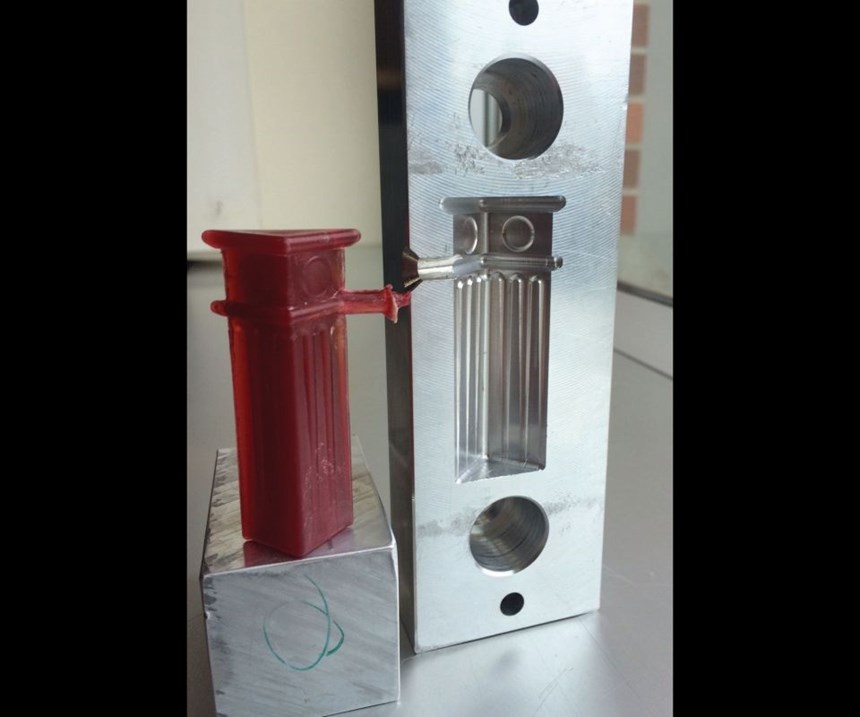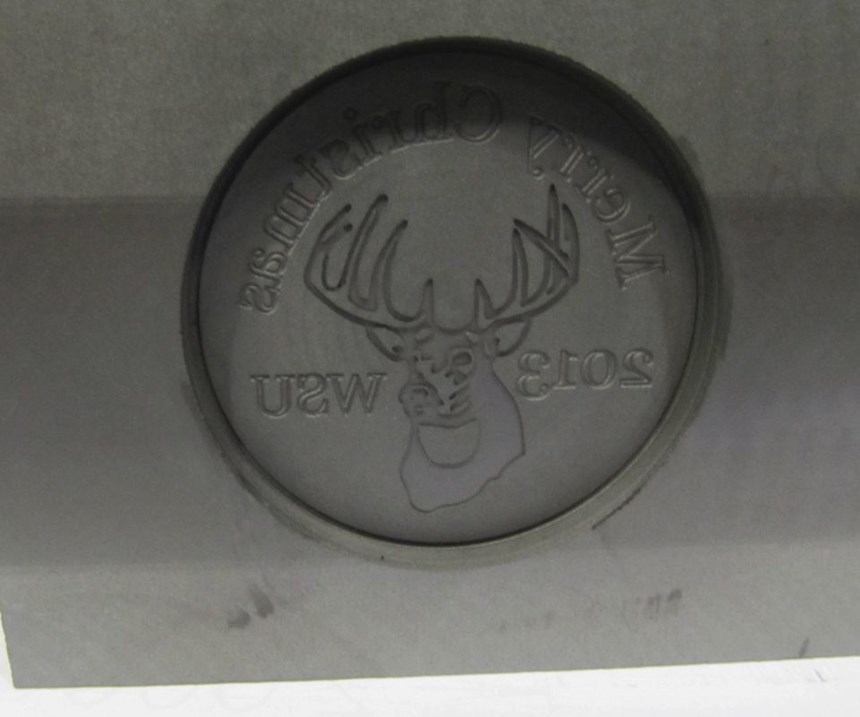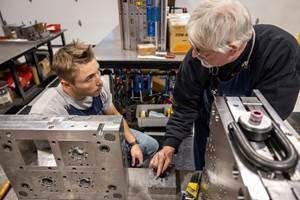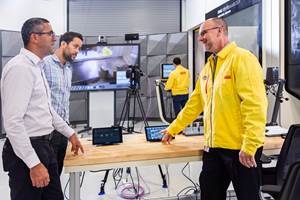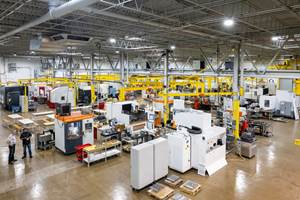Project-Based Learning
University education in a shop-like setting helps mold a new generation of enterprising engineers.
Each year, universities everywhere graduate classes of educated students, each of whom presumably has been molded to be a good, productive member of our society. At Washington State University (WSU) in Pullman, Washington, the term molded takes on addi-tional meaning for its mechanical engineering students.
The Cougar Shop, the working “lab” at WSU’s School of Mechanical and Materials Engineering, has been run by Robert “Kurt” Hutchinson since 2013. From the beginning, he set out to run a technically advanced shop—one that makes use of CNC machines as well as other, more standard equipment like drill presses and band saws that the students would encounter in a real work environment. The shop now features two Haas Minimill vertical machining centers and two Haas TL-1 CNC toolroom lathes, as well as a Fadal 3016 CNC machine with more capacity, a Bridgeport mill and two other lathes.
At the time that Hutchinson took over, students in the Cougar Shop were doing manual data input (MDI) programming, but the lack of advanced software for more refined NC programming limited the sophistication of the work they could do. With the support and expertise of Dan Newby, a fellow WSU alumni and educational programs manager for CNC Software, Hutchinson invested in one seat of Version 5 to take advantage of the capabilities of the company’s Mastercam / CNC Software CAD/CAM product, including multi-axis programming. Today, the Cougar Shop is using Version X9 to not only program multiple axes, but also for high-speed machining and dynamic high-speed milling, as well as surface finishing.
A Hands-On Education
Hutchinson teaches five sections of WSU’s junior-level mechanical engineering class, ME 311. Of the 80 students in those classes, he estimates that only 10 to 15 percent have any type of shop experience, and in these cases usually because members of their families own or work at a manufacturing company. For this reason, he starts everyone out working on conventional machine tools such as the Bridgeport milling machine or LeBlonde manual lathes with digital readouts.
Students are required to complete two projects in this class, using the conventional equipment to machine aluminum workpieces and hone basic turning, facing and knurling skills used in metalworking. After those project pieces are completed on the conventional equipment, the designs are converted so that the students can use the more advanced CNC equipment and software to make the same parts.
They begin with MDI programming on the Haas VMC, which features the company’s Intuitive Programming System (IPS), a graphics interface on the controllers. This enables the students to input parameters that the machines translate into G code. From the IPS, the students progress into learning more advanced subjects, including Mastercam X9 programming, as well as threading, contour milling, dynamic high-speed pocket milling, thread milling and engraving. They finish out the course by using Mastercam and the more advanced machines to further customize the two parts they manufactured on the conventional equipment.
“The best part of my job is when I see the connections being made between the students and the machine tools as they watch their parts being made,” Hutchinson says.
Adding Moldmaking to the Mix
In 2014, Hutchinson and three student assistants took a class on moldmaking at CNC Software’s Gig Harbor, Washington, facility, where the company offers instructor training during the summer. Hutchinson notes proudly that his students were the fastest finishers of the course project.
The group incorporated what they learned into the project-based curriculum for their ME 475 class, which Hutchinson calls an “enterprise engineering” class, because it focuses on systems design, manufacturing processes and programming for manufacturing. He and his student assistants proceeded to build their own small injection molding machine, using pneumatic cylinders Hutchinson had at the shop, along with a Bosch frame that was fitted with aluminum to form its exterior and with hardened steel for the main chamber. They also used scrap brass material to build the nozzle and employed an old milling machine vise for workholding.
Hutchinson says the machine, which is about 24 inches wide and 18 inches tall, looks like it was invented by cartoonist Rube Goldberg, “but it works great!” The class primarily has used styrene for injection molding, but he says high-density polyethylene (HDPE) and other polyethylene materials also work well in it, and the students have experimented with other materials as well. They also have tested different coatings, temperatures and other factors to learn more about molding in general.
Although the simple injection machine’s size and volumetric capacity limits molding to either very small parts or larger parts in multiple pieces, all the students were able to design and build their own single-cavity aluminum molds and then mold their own parts. Each student was given a set of aluminum soft jaws out of a 6-inch vise to serve as the A and B halves of their molds. They used end mills as small as 0.020 inch and a variety of surface-machining and high-speed pocketing techniques to machine molds for parts that included a mouthpiece for a trumpet and a replica of a clock tower on the WSU campus.
Building the injection molding machine also gave the students the opportunity to improve upon existing technology. For example, the injection molding machines they used in Gig Harbor featured temperature controllers that worked much like thermostat knobs. Hutchinson and his crew ordered a proportional–integral–derivative (PID) controller, built a thermocouple and installed it on their unit, adding a pressure-relief valve that retracts after the machine finishes its operation.
“Because they had experience through the ME 311 course, the students were able to really push the boundaries of what students had been able to do with machine work in the past,” Hutchinson says, offering up their proficiency in creating projected tool paths as an example. One student in the ME 475 class wanted to make a grip for the handle of his father’s Colt 45 handgun. Using the Haas Minimill with 1/4 and 1/8-inch ballnose end mills, he machined a pocket, engraved the knurling in it and, using Mastercam, projected the tool path of a cougar image inside the 3D part. He also “checkered” the surface of the tool path, adding some detail to the mold with a carbide engraving cutter.
Projects like this encourage students to think imaginatively and explore their own creativity and practical skills, Hutchinson says. WSU’s Cougar Shop provides sophisticated software and high-tech machinery, as well as the opportunity to investigate the possibilities through project-based learning. No matter where each of them ends up after graduation, Hutchinson and the program strive to ensure that they are well-prepared for careers in manufacturing.
Related Content
Confronting the Mold Design Talent Drought
Recently, I reposted on LinkedIn the results of an informal survey we conducted, which revealed a shortage of skilled mold designers. It quickly gained a lot of traction. Given the response, I thought I'd summarize the feedback and keep the conversation going.
Read MoreEden Tool and Eden Manufacturing: A Story of Resilience, Growth and Innovation
This critical parts manufacturer, founded on solid tooling fundamentals, didn’t get derailed with the unexpected passing of the owner because leadership was already building a solid business, not just a good tool shop. Here’s how they managed change incrementally… and they’re not finished yet.
Read MoreHow to Use Continuing Education to Remain Competitive in Moldmaking
Continued training helps moldmakers make tooling decisions and properly use the latest cutting tool to efficiently machine high-quality molds.
Read MoreCross Training, In-House Capabilities and Collaborative Design Move Helm Tool Forward
Cross-training, bringing it all in-house, molding and collaborative design are essential to Helm Tool's success.
Read MoreRead Next
Identifying and Examining Training Constraints
Finding, Training & Retaining Employees, Part 13
Read MoreAre You a Moldmaker Considering 3D Printing? Consider the 3D Printing Workshop at NPE2024
Presentations will cover 3D printing for mold tooling, material innovation, product development, bridge production and full-scale, high-volume additive manufacturing.
Read MoreHow to Use Continuing Education to Remain Competitive in Moldmaking
Continued training helps moldmakers make tooling decisions and properly use the latest cutting tool to efficiently machine high-quality molds.
Read More

